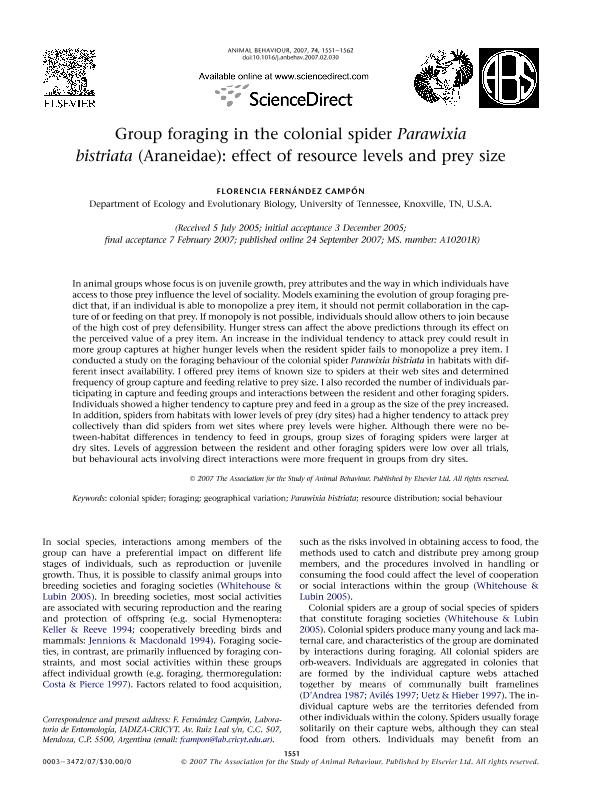Mostrar el registro sencillo del ítem
dc.contributor.author
Fernández Campón, María Florencia

dc.date.available
2019-12-26T15:27:42Z
dc.date.issued
2007-11
dc.identifier.citation
Fernández Campón, María Florencia; Group foraging in the colonial spider Parawixia bistriata (Araneidae): effect of resource levels and prey size; Academic Press Ltd - Elsevier Science Ltd; Animal Behaviour; 74; 5; 11-2007; 1551-1562
dc.identifier.issn
0003-3472
dc.identifier.uri
http://hdl.handle.net/11336/92927
dc.description.abstract
In animal groups whose focus is on juvenile growth, prey attributes and the way in which individuals have access to those prey influence the level of sociality. Models examining the evolution of group foraging predict that, if an individual is able to monopolize a prey item, it should not permit collaboration in the capture of or feeding on that prey. If monopoly is not possible, individuals should allow others to join because of the high cost of prey defensibility. Hunger stress can affect the above predictions through its effect on the perceived value of a prey item. An increase in the individual tendency to attack prey could result in more group captures at higher hunger levels when the resident spider fails to monopolize a prey item. I conducted a study on the foraging behaviour of the colonial spider Parawixia bistriata in habitats with different insect availability. I offered prey items of known size to spiders at their web sites and determined frequency of group capture and feeding relative to prey size. I also recorded the number of individuals participating in capture and feeding groups and interactions between the resident and other foraging spiders. Individuals showed a higher tendency to capture prey and feed in a group as the size of the prey increased. In addition, spiders from habitats with lower levels of prey (dry sites) had a higher tendency to attack prey collectively than did spiders from wet sites where prey levels were higher. Although there were no between-habitat differences in tendency to feed in groups, group sizes of foraging spiders were larger at dry sites. Levels of aggression between the resident and other foraging spiders were low over all trials, but behavioural acts involving direct interactions were more frequent in groups from dry sites.
dc.format
application/pdf
dc.language.iso
eng
dc.publisher
Academic Press Ltd - Elsevier Science Ltd

dc.rights
info:eu-repo/semantics/openAccess
dc.rights.uri
https://creativecommons.org/licenses/by-nc-sa/2.5/ar/
dc.subject
COLONIAL SPIDER
dc.subject
FORAGING
dc.subject
GEOGRAPHICAL VARIATION
dc.subject
PARAWIXIA BISTRIATA
dc.subject
RESOURCE DISTRIBUTION
dc.subject
SOCIAL BEHAVIOUR
dc.subject.classification
Zoología, Ornitología, Entomología, Etología

dc.subject.classification
Ciencias Biológicas

dc.subject.classification
CIENCIAS NATURALES Y EXACTAS

dc.title
Group foraging in the colonial spider Parawixia bistriata (Araneidae): effect of resource levels and prey size
dc.type
info:eu-repo/semantics/article
dc.type
info:ar-repo/semantics/artículo
dc.type
info:eu-repo/semantics/publishedVersion
dc.date.updated
2019-12-05T13:36:01Z
dc.journal.volume
74
dc.journal.number
5
dc.journal.pagination
1551-1562
dc.journal.pais
Países Bajos

dc.journal.ciudad
Amsterdam
dc.description.fil
Fil: Fernández Campón, María Florencia. University of Tennessee; Estados Unidos. Consejo Nacional de Investigaciones Científicas y Técnicas. Centro Científico Tecnológico Conicet - Mendoza. Instituto Argentino de Investigaciones de las Zonas Áridas. Provincia de Mendoza. Instituto Argentino de Investigaciones de las Zonas Áridas. Universidad Nacional de Cuyo. Instituto Argentino de Investigaciones de las Zonas Áridas; Argentina
dc.journal.title
Animal Behaviour

dc.relation.alternativeid
info:eu-repo/semantics/altIdentifier/doi/http://dx.doi.org/10.1016/j.anbehav.2007.02.030
dc.relation.alternativeid
info:eu-repo/semantics/altIdentifier/url/https://www.sciencedirect.com/science/article/pii/S0003347207003181
Archivos asociados
